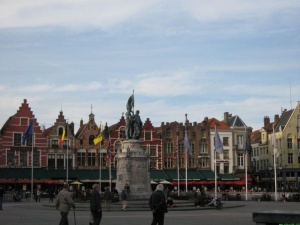When is the Best Time to Visit Bruges?

Bruges, the historical capital of Flemish Belgium, is often referred to as the Venice of the North owing to its labyrinth of glassy-surfaced canals and medieval architecture.
Having grown for centuries on lace and on a key position on the trade routes, the place was designated European City of Culture in 2002 and remains one of the most significant ports of Europe. It attracts up to two million tourists a year.
The historic medieval old town was named a UNESCO World Heritage Centre in 2000. Having undergone a faithful and conscientious restoration programme in 1965, the rejuvenated residential, commercial and civic structures, along with ancient monuments and places of worship, brought a phenomenal influx of both European and international tourists.
Today, city breaks in Bruges remain staggeringly popular, and with plenty of good reason.
So why not take one yourself? Read on for ideas about the best time to consider visiting Bruges.
Warmer months
There’s no time that’s better to visit beautiful Bruges than in the summer. In the warmer months you can join the sedate crowds that pack out the bars and café’s of the Markt and Burg squares to drink cool, foamy Brugge Blond or Brugge Tripel - beers both named in reference to the city.
Indulge in the beer and chocolate festivals and the various musical gatherings that take place in the city, including Blues in Bruges, Burgrock, Jazz Brugge and Fuse on the Beach.
When the weather is good, a trip to nearby Ypres is always recommended. As a significant site in military history, it was the scene for many a gut-wrenching WWI battle and a startling loss of life.
At the Menin Gate, which commemorates the soldiers of the British Empire whose final resting places will be forever unknown, a bugle is sounded daily at 8pm.
Colder months
In cooler weather, Bruges takes on a romantic air as it turns into a city of mellow mists, roaring hearth fires and the famous Christmas Markets. Here you can drink warm mulled wine, eat hot waffles and indulge on scrumptious Belgian chocolates.
Speaking of confectionary, the Belgians’ expertise in the subject is well commemorated by the chocolate museum, one of the specialist palaces of historic memorabilia in the city - others include the diamond museum and the lamp museum (Lumina Domestica).
This is a city replete with grand and eclectic museums and galleries, including the Groeningemuseum which showcases Flemish art from the 15th to the 21st century, including the world-famous Flemish Primitives; Arents House, which showcases rolling exhibits of Expressionist Art and the Bruggesmuseum, which is the collective name for a selection of 11 different museums dotted around the city.
None of this is to forget the key medieval structures that make the city such a visual treat: the Church of our Lady with its colossal 122.3 metre brick spire (which has earned it a place as one of the world’s tallest brick structures), the Basilica of the Holy Blood and the ornate City Hall on the Market Square.

